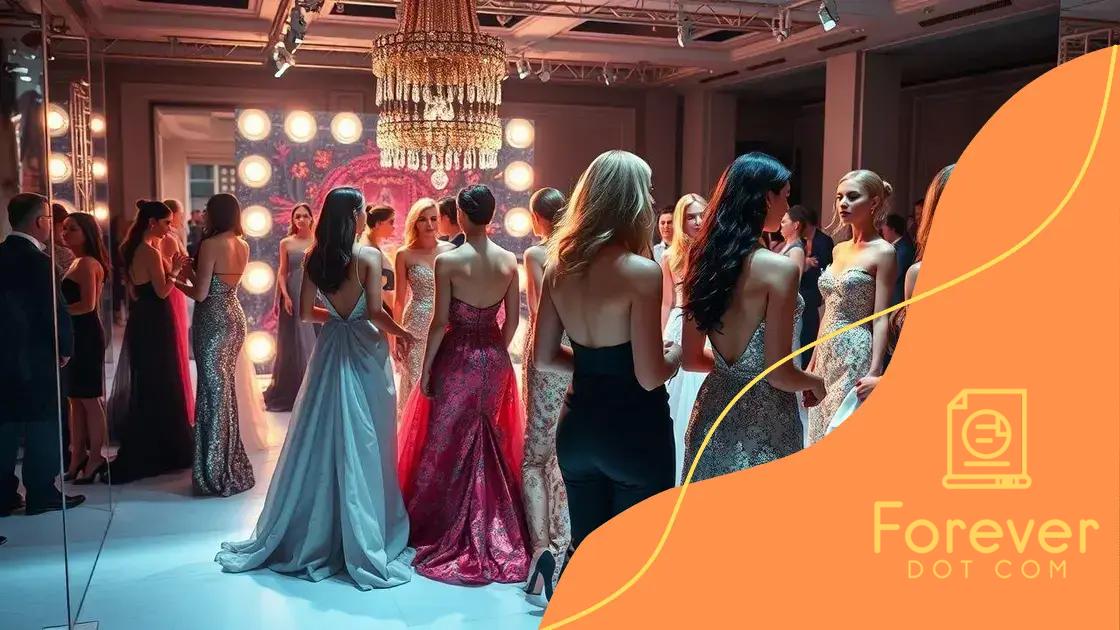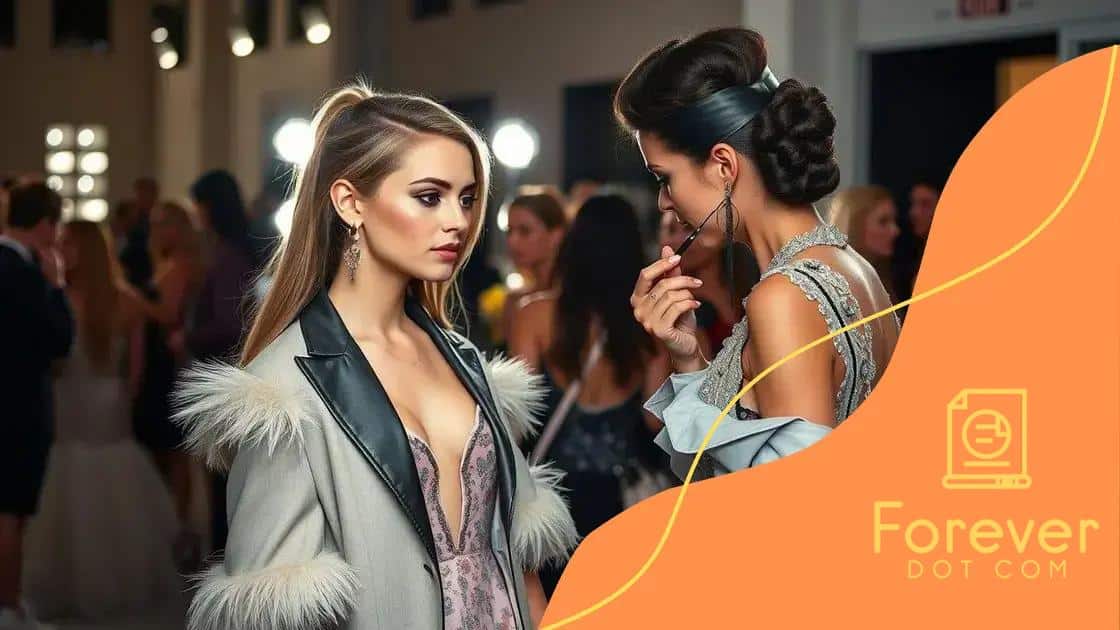Behind the scenes of high-profile fashion galas

High-profile fashion galas significantly impact fashion trends by showcasing innovative designs, colors, and styles that influence consumer preferences and inspire designers worldwide.
Behind the scenes of high-profile fashion galas offers a glimpse into the secrets that create an unforgettable experience. Have you ever wondered what really goes on before those stunning outfits strut down the runway? Let’s dive in.
The art of designing exclusive fashion pieces
The art of designing exclusive fashion pieces is a fascinating blend of creativity and technical skill. Designers pour their hearts into creating pieces that are not only beautiful but also tell a story. Understanding the process behind this art form helps to appreciate the craftsmanship involved.
Key Elements of Fashion Design
Fashion design relies on several critical components that shape the final piece. The use of color, texture, and silhouette can dramatically influence the overall appeal. Each of these elements must be carefully considered throughout the design process.
- Color: Color can evoke emotions and set the mood of the piece.
- Texture: Different fabrics add unique feels and functions to the designs.
- Silhouette: The shape of the garment defines its style and impact.
- Patterns: Unique patterns can make a piece stand out and showcase originality.
Before starting the design, it’s essential for fashion designers to conduct thorough research. This research often involves exploring current trends, historical fashion, and even art movements. Designers gather inspiration from various sources, including nature, architecture, and diverse cultures. This wide array of resources helps to create pieces that resonate with a target audience.
Sketching Ideas
Once the research phase is complete, designers move on to sketching their ideas. Sketches serve as the foundation for the piece, allowing designers to visualize their thoughts. These drawings often evolve through several iterations, ensuring every detail is perfected before moving forward. After finalizing a sketch, designers select the appropriate materials to bring their vision to life.
The process of creating exclusive fashion pieces is not just about aesthetics; it also involves practicality. Designers must consider how the garment will be worn and the comfort it provides to its wearer. For instance, a stunning gown may be perfectly designed, but if it is uncomfortable, it won’t get the appreciation it deserves. Balancing beauty and wearability is crucial in this art form.
In summary, the art of designing exclusive fashion pieces combines imagination with meticulous planning. Designers utilize their skills to create garments that inspire and captivate. This intricate process showcases the beauty of fashion as an evolving art form, encouraging creativity and expression.
Preparing models for the runway
Preparing models for the runway is a critical aspect of high-profile fashion galas. This preparation involves much more than just wearing fabulous outfits; it is about creating an overall look that impresses the audience and showcases the designer’s vision.
The journey begins long before the actual event. Models go through intense training sessions where they learn to walk confidently on the runway. This training helps them perfect their strut, learn how to pose, and understand the importance of body language in conveying the designer’s message. A confident walk can make all the difference on stage.
Essential Steps in Model Preparation
Once the basics of walking are mastered, each model undergoes specific preparation for the show. From fittings to makeup, every detail matters.
- Fittings: Models attend multiple fittings to ensure the outfits fit perfectly. Designers make adjustments to enhance fit and style.
- Makeup and Hair: Professional stylists work on makeup and hairstyles that complement the outfits and reflect the overall theme of the show.
- Rehearsals: Models participate in rehearsals to practice their walks and routines, ensuring they are synchronized with music and lighting.
- Final Touches: Last-minute adjustments are made, and models are briefed on their roles during the show.
The atmosphere backstage is often buzzing with excitement and nerves. Models share tips, encourage each other, and prepare to showcase their hard work. The support system among models can be vital, as the pressure to perform is high. Being part of a team also helps alleviate pre-show jitters.
As the show approaches, models receive a final rundown of important details. They are reminded to stay focused and embody the essence of the designs they wear. Each model represents the brand, and they must coordinate with the designer’s artistic vision.
The role of stylists and makeup artists

The role of stylists and makeup artists is essential in the world of fashion galas. They help transform models into stunning figures that embody the designer’s vision. Their work is crucial in making sure every detail looks perfect on the runway.
Stylists focus on enhancing each model’s look by choosing the right outfits, accessories, and shoes. They have a keen eye for color and style, ensuring that every piece comes together seamlessly. These experts play a key role in communicating the theme of the show through the model’s appearance.
Key Responsibilities of Stylists
Stylists have various important tasks that contribute to the overall success of a fashion show. Here are some of the main responsibilities they fulfill:
- Curating Outfits: Stylists select outfits that best represent the designer’s collection and the show’s theme.
- Accessorizing: They choose accessories that complement the outfits, enhancing the overall look.
- Coordinating with Designers: Stylists work closely with designers to ensure that their vision is fully realized on each model.
- Conducting Fittings: They oversee fittings to make necessary adjustments for the best fit and appearance.
On the other hand, makeup artists bring the models’ looks to life with their artistic skills. Their work involves choosing colors and styles that will stand out under the bright runway lights. They must consider the overall theme of the event while also ensuring that makeup enhances the model’s natural beauty.
Makeup Artists’ Impact
The impact of makeup artists cannot be underestimated. They have to understand the designs and respond to the moods that the designers want to create. A well-executed makeup look can elevate an outfit and add depth to the fashion presentation.
- Color Choices: Makeup artists select colors that not only match the outfit but also pop on the runway.
- Application Techniques: They use various techniques to create looks that feel fresh and exciting.
- Skin Care: Preparing the model’s skin is essential for a flawless makeup application.
- Final Touches: Before the model steps onto the runway, makeup artists add final touches to ensure everything looks perfect.
Collaboration between stylists and makeup artists is key to achieving a cohesive look for each model. Both professionals must communicate effectively to ensure their efforts align with the designer’s vision.
Logistical challenges in gala organization
Logistical challenges in gala organization play a significant role in the success of high-profile fashion events. Organizing a gala involves careful planning and coordination to address various factors that can impact the overall experience.
One of the primary challenges is selecting the right venue. The venue must not only be visually appealing but also accommodate the expected number of guests. Space limitations can lead to overcrowding or, conversely, a lack of atmosphere if the venue is too large. Finding a suitable location that meets both aesthetic and capacity requirements is crucial.
Key Logistical Considerations
Beyond the venue, several logistical considerations must be managed to ensure a smooth event. Here are some important factors:
- Timeline Management: Creating an effective timeline is essential. It outlines each step, making sure everything happens on schedule.
- Vendor Coordination: Organizers must work with various vendors for catering, lighting, and sound. Effective communication with these vendors is key for success.
- Guest List Management: Managing RSVPs and creating an accurate guest list can be challenging, especially when dealing with high-profile individuals.
- Security Measures: With many influential guests attending, security is paramount. Proper arrangements must be made to ensure safety.
Another challenge is managing transportation. Guests and participants need to arrive on time, and ensuring adequate transportation options is vital. This includes arranging shuttles, parking facilities, or even coordinating with ride-sharing services to facilitate ease of access. Timely transportation contributes significantly to guest satisfaction.
Technical setup is equally important. Sound systems, lighting fixtures, and projection equipment must function perfectly. Testing all technical components ahead of time can prevent unexpected issues during the event. A last-minute glitch can disrupt the entire show, making thorough preparation essential.
In summary, tackling logistical challenges requires a comprehensive approach, focusing on every detail of the gala organization. From venue selection to transportation and technical elements, each factor contributes to the overall success of the fashion event.
The impact of high-profile galas on fashion trends
The impact of high-profile galas on fashion trends is significant and far-reaching. These events serve as platforms where designers showcase their latest creations and the fashion world watches closely. Trends often emerge directly from what is seen on the red carpet and in the audience.
Fashion trends are shaped by the bold statements made during these galas. Designers use the runway to present innovative ideas that challenge the status quo. For instance, a striking gown worn by a celebrity can inspire similar designs across the industry. This influence creates a ripple effect, leading to new styles and ideas in boutiques and online stores.
Key Trends that Emerge
Some of the trends witnessed after major galas include:
- Color Palettes: Colors seen on the red carpet can dictate what shades become popular in the upcoming seasons.
- Silhouettes: Unique silhouettes showcased at galas often inspire designers to create their versions for the mass market.
- Accessories: The accessories worn by attendees can lead to trends in jewelry and handbags that reflect luxury and elegance.
- Fabric Choices: The materials chosen for garments can set new standards for what is fashionable, encouraging designers to explore innovative textiles.
Moreover, high-profile galas often receive extensive media coverage. This exposure magnifies the effect of these events on fashion. Magazines, blogs, and social media platforms highlight standout outfits, further promoting those trends. Social media, in particular, allows for fast sharing of trends, as influencers emulate styles seen on the red carpet.
The conversation surrounding what celebrities are wearing impacts consumer behavior. Many people look to videos and photos from galas to guide their fashion choices. This demand results in a rise in inspired pieces that reflect the latest styles showcased at these glamorous events. In turn, retailers quickly adapt their inventories to meet the preferences of consumers influenced by the gala’s fashion statements.
FAQ – Frequently Asked Questions about High-Profile Fashion Galas
What are high-profile fashion galas?
High-profile fashion galas are prestigious events where designers showcase their latest collections, often attended by celebrities and influencers.
How do fashion galas influence trends?
Fashion galas set trends by showcasing unique styles, colors, and designs that are later adopted by consumers and retailers.
What role do stylists and makeup artists play in galas?
Stylists and makeup artists transform models, ensuring their looks align with the designer’s vision and contribute to the overall aesthetic of the event.
Why are logistics important for organizing galas?
Logistics are critical to ensure that every aspect of the event runs smoothly, including venue selection, vendor coordination, and guest management.






